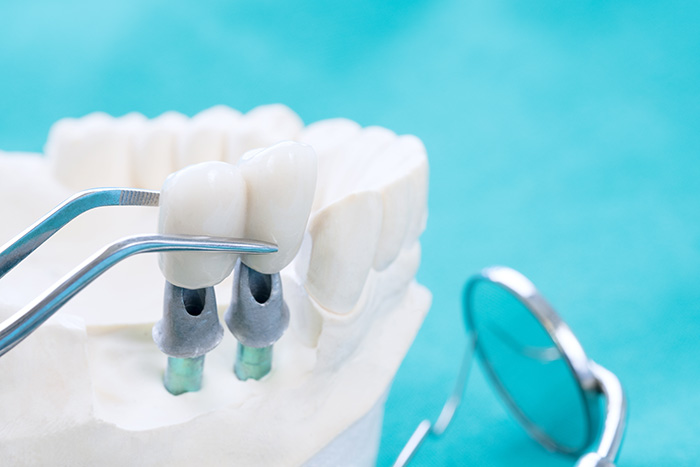Dental implants are the healthiest and most comprehensive dental restoration method, whether you want to replace a single tooth or a mouthful of missing teeth.
While other tooth-replacement techniques may be faster, they only address the visible portion of your missing tooth and ignore the root.
Dental implants restore the whole tooth from root to crown.
Why Are Tooth Roots So Important?
Imagine trying to build a house without a foundation and, instead, attach it to the adjacent homes to keep it securely in place.
If there are no structural threats, the house may last temporarily, but even the mildest weather event will eventually cause it to shift.
You need a foundation to ensure the stability and strength of your house so that you can feel protected, safe, and confident. The same is true for your smile.
Tooth roots offer stability and security when eating your favorite foods, allow your teeth to withstand minor trauma, and stimulate your gums and underlying jawbone every time you chew.
Why Does Gum and Jawbone Stimulation Matter?
Your smile is made up of more than just the crowns of your teeth. The visible crown, roots, soft tissue (gums), and jawbone all work together and must be well-cared for to avoid infection, gum disease progression, and tooth loss.
Having a tooth root keeps your jawbone and tissues stimulated, which keeps your jaw healthy. Without it, the bone begins to lose mass and density — a process called resorption — which ultimately causes the jaw to shrink.
In addition to jaw problems, you may also be at greater risk of developing severe periodontal disease and may suffer from frequent infections or other serious health issues caused by an abundance of potent oral bacteria. Treating periodontal disease as soon as possible helps prevent related tooth loss and keeps your teeth, gums, and jawbone healthy.
If you have already lost one or more teeth, replacing them with dental implants can save you from the potential disfiguring consequences of jawbone resorption.
Is the Extra Time Needed for Dental Implants Worth It?
It’s worth taking the extra time to receive dental implants, especially if your tooth loss was caused by gum disease.
However, choosing a traditional bridge is a suitable solution if you’ve only lost one tooth due to an injury or deep decay, have no significant gum disease, and don’t have the time to spend on a dental implant.
Dental Implant Placement Timeline
For anyone with more than one or two unhealthy, loose, or missing teeth due to periodontal disease, making the investment and taking the time needed to receive dental implants is the only way to ensure the health of your jaw.
The following timeline can help you understand what to expect and how long it may take for you to have dental implants placed:
1. Consultation and Imaging – (Usually Only One Day)
Try to arrange for any required imaging to occur on the same day as your consultation, and if possible, choose an experienced, comprehensive dentist equipped with advanced imaging technology. A qualified dentist will examine your teeth, gums, and jawbone thoroughly and review all images carefully.
Supportive Treatments – (Three to 12 Months)
In cases where gum disease has already begun to destroy oral tissues, pre-placement treatments and surgeries like periodontal treatments, tooth extractions, and bone grafts are necessary before the dental implants can be inserted.
Depending on your specific oral health issues and the extent of damage, it may take three months to a year before your gums and jawbone are ready to receive the implants.
2. Dental Implant Placement – (One to Two Weeks)
If your gums and jaw are healthy, your implant can be placed anytime after your initial consultation (usually within two weeks). Titanium implant posts are inserted into the jawbone for each tooth being replaced, according to your custom treatment plan.
Sometimes, when all or most teeth are missing, four or more posts may be inserted to support a modified denture (implant-supported denture).
3. Osseointegration – (Approximately Three to Six Months)
Depending on the number of implants, initial recovery from dental implant placement may take up to two weeks.
However, the magic of dental implantation is just beginning. The implant post must also fuse with your jawbone (osseointegrate) to function like a natural tooth root.
During this phase, you’ll be scheduled for a few follow-up visits, and when the gums are fully healed, your dentist will obtain dental impressions and images of your gums, implant post(s), and healthy teeth. These are sent to our trusted dental lab to create your permanent crown(s).
4. Receiving Your Abutment(s) – (Up to Two Weeks)
About two weeks before receiving your final restoration(s), abutments will be attached to each implant post to ensure a strong and secure bond between the crown and implant.
A temporary crown will be placed over the abutment.
5. Receiving Your Crown(s) – (Usually One Day)
You’ll receive your final restoration (porcelain crown) between one and two weeks after having your abutment placed.
The crown is then securely bonded to the abutment, and this process is repeated for any additional individual dental implants.
Your San Diego, CA, Dental Implant Provider
Dr. Kohani is committed to providing the highest level of dental care and offers customized treatment plans to meet the diverse needs of his San Diego dental implant patients.
La Jolla Cosmetic Dentistry & Orthodontics is equipped with advanced 3D imaging technology, which allows Dr. Kohani to diagnose and treat damaged teeth or gum disease precisely and determine if dental implants are right for you.
Call our San Diego, California, dental implant provider at (858) 281-0653 today!


